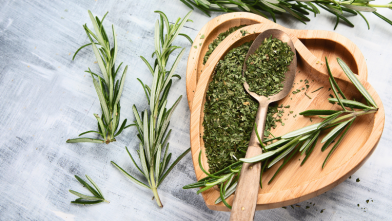Want a kitchen hack that will boost the flavor of dozens of recipes and help keep things healthy and diabetes-friendly? Use homemade stock or broth wherever you can.
You may be wondering what the difference is between stock and broth. Stock is made from simmering bones in water and broth is made from simmering meat (and sometimes bones). They both create a flavor-boosted liquid, but stock is thicker than broth because of the collagen and gelatin that is released from the bones. You can also make vegetable stock (usually unseasoned and made from whole vegetables) and broth (usually seasoned and made from roughly chopped vegetables).
By making your own, you can:
- Swap it out for store-bought in recipes that call for broth or stock
- Substitute it for water when boiling veggies or grains to add more flavor
- Use it in soups, stews, and chilis
You’ll be amazed at how much flavor it adds to a recipe. By preparing it at home, you can cut the sodium without cutting the taste and save money. If you’re worried about making stock or broth at home—don’t be! It’s very simple and the payoff is worth it.
D-I-Why?
Not only can you build your own flavor profile with homemade stock or broth, you also have control over how much salt is added. Store-bought stocks and broths are often very high in sodium. While the reduced sodium options are better if you’re watching your salt intake, even those can have a lot of sodium. When you make your own stock or broth, you can leave out the salt and wait to add seasonings to the final dish. And let’s not forget about the cost savings. Homemade stock can be prepared at a low cost when you make it from non-starchy vegetables (e.g., onions, celery, carrots), meat, or chicken, or turkey bones you would have otherwise thrown away!
Do you buy rotisserie chicken at the store? Save the bones and store them in the freezer until you are ready to make stock. Keep a “scrap bag” in the freezer to collect vegetable peels and scraps so those are also ready to throw in the pot. All it takes to make stock is meat bones (beef, chicken, or turkey) and water. If you want more flavor, go ahead and throw in a mixture of basic vegetables like onions, carrots, and celery. Got herbs? Sure! Those parsley stems are full of flavor, so why throw them away when they can go in the pot? For vegetarians, you can skip the bones and just make a flavorful vegetable broth from all your produce scraps.
How to Make Your Own Stock
The technique is easy for all:
- Brown the bones, vegetables, or mushrooms with a little bit of oil in a large stockpot, making sure to develop crusty bits on the bottom of the pan (those bits will give your stock a major flavor boost).
- Add enough cold water to cover the ingredients and stir, being sure to scrape all of the crusty bits from the bottom of the pan with your spoon. Bring to a boil, then lower the heat and simmer gently.
- For chicken stock, simmer for at least 30–45 minutes and up to two hours, depending on the amount of bones. Mushroom or vegetable stock only needs to simmer 10–30 minutes.
- Let the broth cool, then strain through a fine mesh strainer. Store in airtight containers in the fridge for up to three days or in the freezer for three months. To make individual portions of stock, pour it into an ice cube tray and freeze. When you need it in a recipe, pop out one or two cubes to use!
As simple as it is, there are a few important things to pay attention to:
- Check on the stock while it’s simmering and skim off any foam on top. Otherwise, your stock could taste slightly bitter.
- Be sure to strain the liquid well by using a very fine strainer (called chinois) or a wire mesh strainer lined with a cheese cloth. The pieces of food left in the liquid may add flavors you don’t want.
- In the case of chicken stock, try to make sure the bones are clean of meat. The bones are the source of gelatin or collagen and flavor, not the meat.
Once you start making stock and broth frequently, it gets easier! Try using your homemade stock in your favorite soup recipe, or try one for Butternut Squash and Kale Soup and see the difference between homemade and store-bought for yourself!








